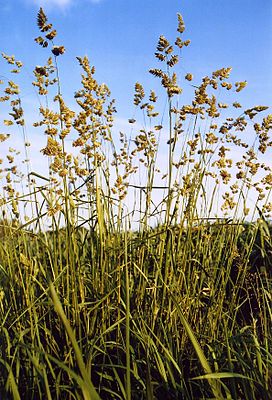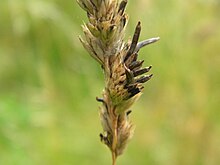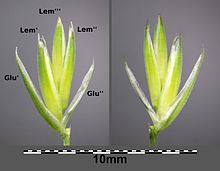Common ball of grass
| Common ball of grass | ||||||||||||
|---|---|---|---|---|---|---|---|---|---|---|---|---|

Common ballgrass ( Dactylis glomerata ) |
||||||||||||
| Systematics | ||||||||||||
|
||||||||||||
| Scientific name | ||||||||||||
| Dactylis glomerata | ||||||||||||
| L. |
The common ball grass ( Dactylis glomerata ), also meadow ball grass or clump grass , is a species of the sweet grass family (Poaceae). As an important pasture and hay grass , it is of economic importance for humans.
description
Vegetative characteristics
The ordinary orchard grass is a gray-green colored, strong, in Horsten growing perennial , herbaceous plant reached, the growth heights of up to 120 centimeters. Its leaves are 4 to 10 millimeters wide, with the top one sticking out straight.
Generative characteristics
The flowering period usually extends from May to July, but can also exceptionally - depending on the circumstances - last until December. The paniculate inflorescence is narrow both before and after the anthesis , otherwise often broadly fanned out and forms a triangular outline. In contrast to the forest ball of grass , it is tightly tangled, with a lower branch that protrudes far, which is later pulled together, and an upright tip. The spikelets are three to five flowered. The glume is coarse, not translucent, green, reddish, rarely purple in color. The lower glume is single-nerved. The keel of the upper glume and the lemma is covered with long and short stiff hairs. The entire surface of the lemma is usually covered with long hairs and suddenly narrowed in a distinct awn, 1 to 2 millimeters long on the lower flowers .
The number of chromosomes is 2n = 28, less often 14.
ecology
The common ball of grass is one of the hemicryptophytes .
The common ball of grass is wind-blooming of the "long-dust thread type". The pollen often causes hay fever . The flowers are self-sterile, rarely also pseudoviviparous d. H. Brood buds form in the inflorescence , which are used for vegetative reproduction.
The caryopses (= husk fruits) surrounded by the palea and the ciliate lemma serve to spread , which are not only subject to Velcro spreading but also to swimming and wind spreading. It also spreads randomly through the hay and pasture forage. The fruit ripens between August and October. The plant is a winter stand and light germinator.

Diseases
The common ball of grass is attacked by ergot fungus .
Occurrence
The common ball of grass is widespread in the temperate zones of Eurasia to the Mediterranean and also in Macaronesia. In many other countries, in America, Australia and New Zealand it is a neophyte. It also occurs all over Germany ; Above all, it can be found on meadows, on roadsides, ruderal spots , on the edges of forests and on forest fields . It occurs mainly in societies of the order Arrhenatheretalia, but also in those of the associations Mesobromion, Alno-Ulmion, the order Atropetalia and the class Artemisietea. In the Allgäu Alps in Vorarlberg on the Üntscheller it rises up to 2000 meters above sea level.
The common ball of grass thrives best in fresh , nutrient-rich soils . It's a nitrogen pointer . When over-fertilized , it competes with many herbaceous plants and thus contributes to the “greening” of the meadows . On the other hand, through regular early use of silage or hay, the ball of grass is pushed back, with an increase in “ weeds ” and especially dock .
Systematics
The first publication of Dactylis glomerata was in 1753 by Carl von Linné in Species Plantarum . According to R. Govaerts, the species Dactylis glomerata L. is divided into 19 subspecies:
- Dactylis glomerata subsp. glomerata : It occurs from the Mediterranean to the temperate zones of Eurasia and Macaronesia.
- Dactylis glomerata subsp. hackelii (Asch. & Graebn.) Cif. & Giacom. : It occurs in the Mediterranean and Madeira .
- Dactylis glomerata subsp. hispanica (Roth) Nyman (Syn .: Dactylis hispanica Roth ): It occurs from the Mediterranean area to Afghanistan and Madeira.
- Dactylis glomerata subsp. hyrcana Tzvelev : It occurs in the eastern Transcaucasia.
- Dactylis glomerata nothosubsp. intercedens (Domin) Acedo (Syn .: Dactylis × intercedens Domin ) = Dactylis glomerata subsp. glomerata × Dactylis glomerata subsp. lobata : It occurs in Germany and the Czech Republic.
- Dactylis glomerata subsp. izcoi S.Ortiz & Rodr.Oubiña : It occurs in Portugal and Spain.
- Dactylis glomerata subsp. judaica Stebbins & D.Zohary : It occurs in Israel.
- Dactylis glomerata subsp. juncinella (Bory) Stebbins & D.Zohary (Syn .: Dactylis juncinella Bory ): It occurs in the Sierra Nevada in southern Spain and in Morocco.
- Forest orchard grass ( Dactylis glomerata subsp. Lobata (Drejer) H.Lindb. , Syn .: Dactylis polygama Horv. , Dactylis glomerata subsp. Aschersoniana (Graebn.) Thell. , Dactylis glomerata subsp. Polygama (Horv.) Domin , Dactylis glomerata var. lobata Drejer , Dactylis lobata (Drejer) Ostenf. ): It occurs from Western Europe and Central Europe to the Caucasus.
- Dactylis glomerata subsp. lusitanica Stebbins & D.Zohary : It occurs in northwestern Spain and in central Portugal.
- Dactylis glomerata subsp. mairei Stebbins & D.Zohary : It occurs in north-eastern Algeria.
- Dactylis glomerata subsp. merinoana (Horjales, Laso & Redondo) H.Scholz : It occurs in Portugal and Spain.
- Dactylis glomerata subsp. nestorii Rosselló & L.Sáez : It occurs in Ibiza and Formentera .
- Dactylis glomerata subsp. oceanica G.Guignard : It occurs in western and north-western France.
- Dactylis glomerata subsp. richbachii (Dalla Torre & Sarnth.) Stebbins & D.Zohary : It occurs in the Alps of France, Italy and Austria.
- Dactylis glomerata subsp. rigida (Boiss. & Heldr.) Hayek (Syn .: Dactylis rigida Boiss. & Heldr. ): It is endemic to Crete . It grows in Igelpolsterheide at altitudes of 1400 to 2400 meters. The stalks are thick, short and very stiff. The panicle is cylindrical, oblong-narrow and spike-shaped. The ball has 1 to 3 ears, which are 5 to 7 millimeters long. The glumes are glabrous, blunt and very prickly.
- Dactylis glomerata subsp. santai Stebbins & D.Zohary : It occurs in northern Algeria, in Tunisia and maybe also in Morocco.
- Dactylis glomerata subsp. slovenica (Domin) Domin in K.Domin & J.Podpera (Syn .: Dactylis slovenica Domin ): It occurs in the Alps, in the Carpathians and on the northern Balkan peninsula.
- Dactylis glomerata subsp. stebbinsii (Horjales, Laso & Redondo) H.Scholz : It occurs in southern Spain.
- Dactylis glomerata subsp. woronowii (Ovcz.) Stebbins & D.Zohary (Syn .: Dactylis woronowii Ovcz. ): It occurs in the Caucasus.
use
The hay from the stalks has only a limited fodder-building value. The leafy growths are valuable, however. Since the tangled grass forms a lot of clumps, the result is a patchy cover of plants that is little appreciated in pastures.
Common names
The other German-language trivial names exist or existed for the common ball of grass : Chnopfhalm ( St. Gallen ), Gaislagras (St. Gallen, Tyrol , Bern ), Hundsgrab (Tyrol, Bern), cat grass (Bern), ball grass (Bern), knuckle grass ( Silesia ), Schlegelhalm ( Graubünden ), Schliessgras (St. Gallen), Schmärhalm (St. Gallen), Stockgras (Tyrol), Stocklas (Tyrol near Lienz ), Stübergräs (St. Gallen near Obertoggenburg ) and Zötteligras (Bern).
Individual evidence
- ↑ a b Erich Oberdorfer : Plant-sociological excursion flora for Germany and neighboring areas . With the collaboration of Angelika Schwabe and Theo Müller. 8th, heavily revised and expanded edition. Eugen Ulmer, Stuttgart (Hohenheim) 2001, ISBN 3-8001-3131-5 , pp. 226 .
- ↑ a b c Ruprecht Düll , Herfried Kutzelnigg : Pocket dictionary of plants in Germany and neighboring countries. The most common Central European species in portrait . 7th, corrected and enlarged edition. Quelle & Meyer, Wiebelsheim 2011, ISBN 978-3-494-01424-1 , p. 267 .
- ↑ Robert Stäger: Infection experiments with Gramineae-inhabiting Claviceps species. In: Botanische Zeitung. Volume 61, No. 6-7, 1903, pp. 111-158, digitized .
- ↑ a b c d e f g h i j k l m n o p q r s t u Rafaël Govaerts (Ed.): Dactylis glomerata. In: World Checklist of Selected Plant Families (WCSP) - The Board of Trustees of the Royal Botanic Gardens, Kew . Retrieved November 8, 2016.
- ↑ Erhard Dörr, Wolfgang Lippert : Flora of the Allgäu and its surroundings. Volume 1, IHW, Eching 2001, ISBN 3-930167-50-6 , p. 178.
- ↑ Carl von Linné: Species Plantarum. Volume 1, Lars Salvius, Stockholm 1753, p. 71, digitized .
- ↑ Ralf Jahn, Peter Schönfelder: Excursion flora for Crete . With contributions by Alfred Mayer and Martin Scheuerer. Eugen Ulmer, Stuttgart (Hohenheim) 1995, ISBN 3-8001-3478-0 , p. 382 .
- ^ Walter Dietl, Manuel Jorquera: meadow and alpine plants. Recognition by the leaves - delight in the flowers. 3. Edition. Österreichischer Agrarverlag, Vienna 2007, ISBN 978-3-7040-2234-9 , p. 416.
- ^ Georg August Pritzel , Carl Jessen : The German folk names of plants. New contribution to the German linguistic treasure. Philipp Cohen, Hannover 1882, page 127 f. ( Online ).
Web links
- Dactylis glomerata L. s. str., common hogweed. In: FloraWeb.de.
- Common ball of grass . In: BiolFlor, the database of biological-ecological characteristics of the flora of Germany.
- Profile and distribution map for Bavaria . In: Botanical Information Hub of Bavaria .
- Dactylis glomerata L. In: Info Flora , the national data and information center for Swiss flora .
- Distribution in the northern hemisphere from: Eric Hultén, Magnus Fries: Atlas of North European vascular plants 1986, ISBN 3-87429-263-0 at Den virtuella flora. (swed.)
- Thomas Meyer: Data sheet with identification key and photos at Flora-de: Flora von Deutschland (old name of the website: Flowers in Swabia )
- Literature on Dactylis glomerata in the Kew Bibliographic Databases . (English)





